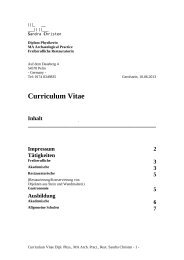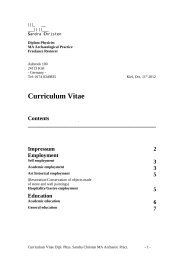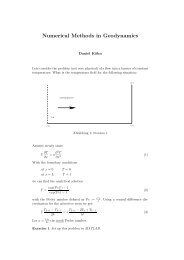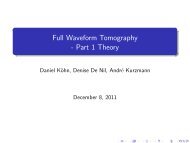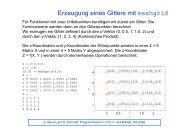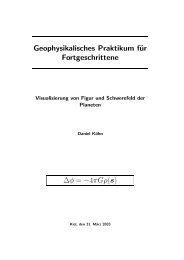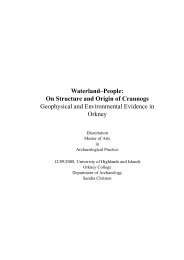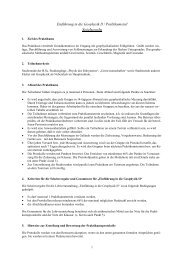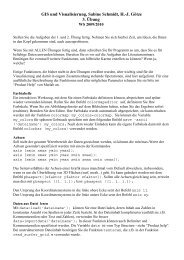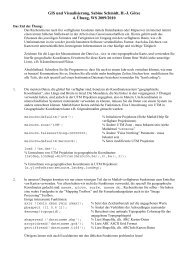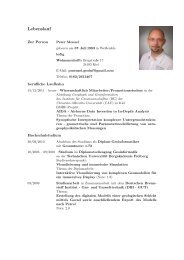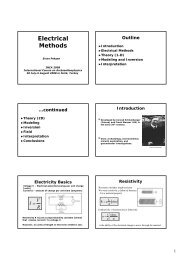Waterland–People: On Structure and Origin of Crannogs ...
Waterland–People: On Structure and Origin of Crannogs ...
Waterland–People: On Structure and Origin of Crannogs ...
Create successful ePaper yourself
Turn your PDF publications into a flip-book with our unique Google optimized e-Paper software.
CHAPTER 6. INTERPRETATION AND 6.4. DISCUSSION<br />
LOGBOATS AND BURNT MOUNDS<br />
board’ that dated to 1043±110 BC <strong>and</strong> had been converted into a trough. It’s location<br />
was rather interesting, too, as it had sunk into the ’edge <strong>of</strong> the lake–bed where it was<br />
firmly wedged between four upright posts; further posts were found flanking the trough<br />
which was interpreted as having been incorporated into the lower part <strong>of</strong> an artificial<br />
platform, the upper parts <strong>of</strong> which had been destroyed by fire. [...] The location is noted<br />
as not being a lake <strong>of</strong> navigable size, while lacustrine deposits were not revealed by<br />
geological sampling. The discovery is re–interpreted as that <strong>of</strong> a bothy <strong>and</strong> work–site <strong>of</strong><br />
comparatively recent date, based on a perpetual supply <strong>of</strong> seepage–water for steeping or<br />
soaking, <strong>and</strong> a supply <strong>of</strong> poles. Skin–dressing, flax–retting <strong>and</strong> basket–making are all<br />
considered possible explanations.’ (Mowat 1996, 148).<br />
Suggesting the re–use <strong>of</strong> logboats in the absence <strong>of</strong> any trees for building troughs in<br />
Orkney, the crannogs or other lake–side sites that could be associated with the boat would<br />
certainly pre–date the burnt mound. Troughs can, nevertheless, easily be build out <strong>of</strong><br />
large slabs <strong>of</strong> stone. The area around Loch Bosquoy, though, is lacking a natural quarry<br />
<strong>and</strong> the re–use <strong>of</strong> building material seems to be the method <strong>of</strong> choice. The only noted<br />
buildings close are the brochs Burrian at the E shore <strong>of</strong> Loch Harray <strong>and</strong> Bosquoy on the<br />
other side <strong>of</strong> the loch, but without excavation, not much can be said.<br />
However, the burnt mounds or mounds <strong>of</strong> burnt stones constitute the most numerous<br />
class <strong>of</strong> antiquity in Orkney with over 200 known sites <strong>and</strong> another 200 in Shetl<strong>and</strong>. The<br />
density <strong>of</strong> this site type therefore exceeds that <strong>of</strong> any other in Britain with the exception<br />
<strong>of</strong> the bronze age round barrow in some areas.<br />
A mound <strong>of</strong> burnt stones is a low heap <strong>of</strong> fire-affected stones intermixed with backened<br />
earth, between 1.5 m height <strong>and</strong> 20 m width. Some have upright slabs <strong>and</strong> narrow cells,<br />
stone tanks <strong>and</strong> are close to the water, a stream or boggy ground <strong>and</strong> come in groups.<br />
The shape is irregular or horseshoe like in plan with the concave part facing the water<br />
(Huxtable et al. 1976, 5).<br />
The excavation at Liddle Farm in South Ronaldsay revealed 200 m 3 <strong>of</strong> burnt stone, ash<br />
charcoal, the remains <strong>of</strong> a small oval house, 6 x 4 m solidly build <strong>of</strong> stone, a large hearth<br />
<strong>and</strong> a stone build trough. Very few artefacts <strong>and</strong> no bone <strong>and</strong> shell were found (Hedges<br />
1974, 8) <strong>and</strong> it was dated to 900–500 BC (Hedges 1974, 10). Fluxgate gradiometry<br />
showes strong permanent magnetic effects <strong>and</strong> increased magnetic susceptibility as a<br />
result <strong>of</strong> heating which gives geophysical confirmation even when the site is entirely<br />
covered with vegetation (Hedges 1974, 8–9).<br />
Hedges (Hedges 1974, 8) suggests the majority <strong>of</strong> burnt mounds was used for cooking<br />
but were primarily settlements because:<br />
1. The large number <strong>of</strong> sites prevents specialization to be the case<br />
2. No other types are known in Orkney for that period<br />
3. Quality <strong>of</strong> construction is high<br />
The limited use <strong>of</strong> pottery could relate to the absence <strong>of</strong> wood as fuel since cooking pots<br />
on peatfire would not survive the heat, that is, if the peat that was fired was <strong>of</strong> normal<br />
69



